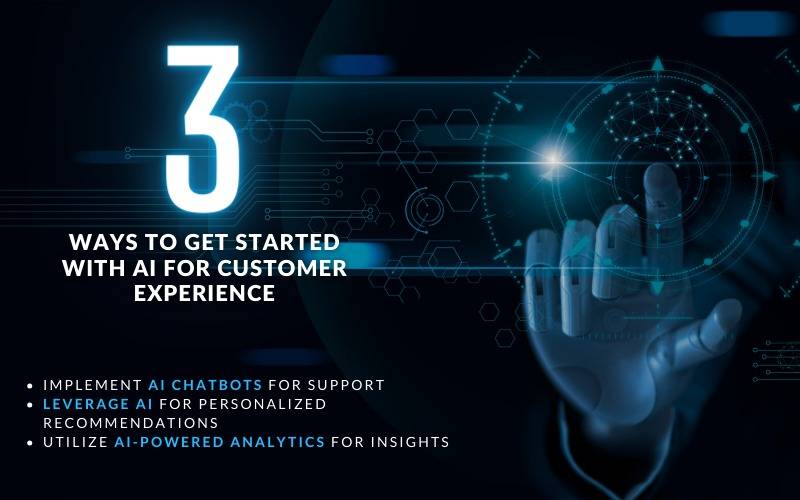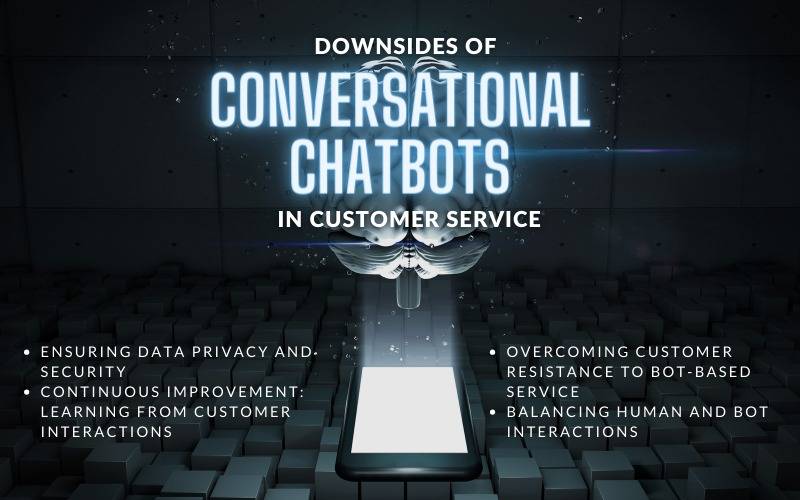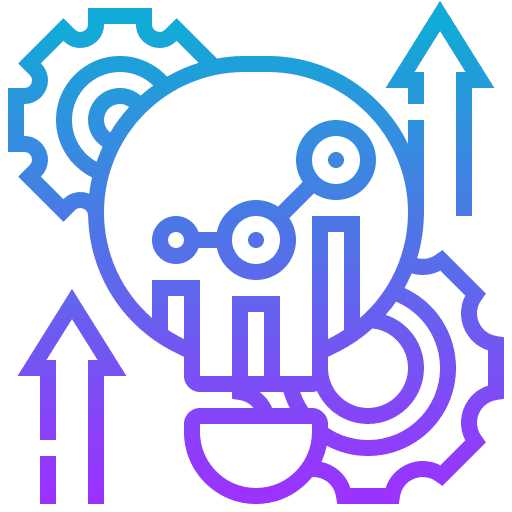The Ultimate Guide to Improving Customer Experience Using AI Chatbots
In the digital era, customer experience has become a key determinant of business success. The integration of Artificial Intelligence (AI) through chatbots is revolutionizing customer service, particularly in Improving Customer Experience using AI Chatbots. These AI-driven chatbots utilize sophisticated algorithms and natural language processing to provide prompt and personalized customer interactions. Their ability to offer 24/7 support across various platforms marks a significant leap towards enhancing the overall customer experience.
The adoption of AI chatbots in customer service operations allows businesses to meet and exceed evolving consumer expectations, playing a pivotal role in Improving Customer Experience using AI Chatbots. By streamlining inquiries and improving response times, these chatbots are setting a new standard in customer satisfaction. As a result, businesses can not only retain their customer base but also attract new clients, showcasing the critical role of AI chatbots in the competitive landscape of the digital age.
Understanding AI Chatbots
What are AI Chatbots?
AI Chatbots are sophisticated software applications equipped with Artificial Intelligence (AI) designed to simulate human-like conversations with users. They are programmed to understand, process, and respond to text or voice inputs from humans, facilitating interactive communication in real-time. Unlike traditional chatbots that operate based on predefined rules, AI chatbots learn from interactions to improve their understanding and responses over time, making them more efficient and human-like in their communication.
The Technology Behind AI Chatbots: Natural Language Processing (NLP) and Machine Learning (ML)
The core technologies that empower AI chatbots are Natural Language Processing (NLP) and Machine Learning (ML). NLP enables chatbots to interpret and comprehend human language, allowing them to understand user queries and context. This understanding is critical for processing requests and providing relevant responses. Machine Learning, on the other hand, is what allows AI chatbots to learn from past interactions.
Through Machine learning algorithms, chatbots analyze data from conversations to identify patterns and improve their accuracy in understanding and responding to user inquiries over time. Together, NLP and ML provide the foundation for creating chatbots that can engage in meaningful and helpful interactions with users.

Types of AI Chatbots and Their Uses in Customer Service
AI Chatbots can be categorized into two main types based on their functionality: task-oriented chatbots and conversational chatbots.
Task-Oriented Chatbots are designed to perform specific tasks or solve particular problems. They are highly focused, providing quick and efficient solutions to user queries, such as booking appointments, answering FAQs, or tracking orders. In customer service, they help streamline operations by handling routine inquiries, freeing up human agents for more complex issues.
Conversational Chatbots, also known as virtual assistants, are equipped to handle open-ended interactions. They are designed to simulate human-like conversations, making the user feel like they’re chatting with a real person. These chatbots are capable of learning from interactions to better understand user preferences and provide personalized assistance. In customer service, conversational chatbots enhance engagement by offering tailored recommendations, support, and guidance, improving the overall customer experience.
Both types of AI chatbots are invaluable tools in customer service, helping businesses automate responses, personalize interactions, and improve customer satisfaction efficiently and effectively.

7 Ways Chatbots Can Improve Customer Experience
AI chatbots are transforming customer service by offering personalized, efficient support around the clock, significantly improving customer experience and satisfaction.
Integration with Big Data Analytics: By integrating chatbots with big data analytics, businesses can analyze large volumes of customer interaction data in real-time. This analysis allows chatbots to understand customer preferences, behavior patterns, and needs better, enabling them to offer more personalized and relevant responses.
Utilizing Advanced NLP Techniques: Employing advanced Natural Language Processing (NLP) techniques enables chatbots to understand and process complex human languages more effectively. Enhancements in NLP allow for better comprehension of customer intents and sentiments, leading to more accurate and human-like interactions.
Implementing Sentiment Analysis: Sentiment analysis algorithms can be integrated into chatbot systems to gauge the emotional tone behind customer inquiries. This allows chatbots to tailor their responses not just to the content of the message but also to the customer’s mood, improving the empathetic engagement of the chatbot.
Adopting Machine Learning for Continuous Learning: Machine learning algorithms enable chatbots to learn from each interaction and improve over time. By analyzing previous conversations, chatbots can identify patterns and refine their responses, making them more effective in handling future inquiries.
Offering Omnichannel Support: Ensuring chatbots are integrated across all digital platforms and channels provides a seamless customer experience. Whether interacting through social media, email, or a company website, customers receive consistent support, enhancing their overall experience.
Voice Recognition and Processing: Incorporating voice recognition and processing capabilities allows chatbots to engage in voice-based interactions. This not only caters to customers’ preferences for voice commands but also makes services more accessible to those with visual impairments or those who prefer speaking over typing.
Blockchain for Security and Privacy: Utilizing blockchain technology can enhance the security and privacy of customer interactions with chatbots. Blockchain’s decentralized nature ensures that customer data is protected, building trust and confidence in using chatbot services.
How Businesses Are Using AI Chatbots to Improve Customer Support
AI chatbots are transforming customer support, offering significant benefits in efficiency, cost management, and customer satisfaction, thereby Improving Customer Experience using AI Chatbots. Here’s how they’re making an impact:
Cost Reduction in Customer Support
AI chatbots dramatically cut costs by handling numerous queries simultaneously, 24/7, without the need for breaks or overtime pay. This reduction in staffing and infrastructure expenses allows businesses to reallocate funds towards growth and development.
Scalability of Customer Service Operations
Chatbots can scale customer service operations effortlessly, managing multiple conversations at once. This capability ensures consistent support quality, even during peak times or product launches, without additional staffing costs.
Gathering and Analyzing Customer Feedback
Through natural language processing and CRM integration, AI chatbots efficiently collect and analyze customer feedback. This immediate insight helps businesses quickly adjust strategies, improve service, and anticipate future needs.
Enhancing Customer Engagement and Loyalty
By offering personalized interactions and proactive support, AI chatbots boost engagement and foster loyalty. Personalized recommendations and attentive service make customers feel valued, enhancing their overall experience and commitment to the brand.

3 ways to get started with AI for customer experience
1. Implement AI Chatbots for Support
Introduce AI chatbots to your customer support to handle inquiries, offer 24/7 assistance, and provide quick responses. Start by setting up chatbots to address frequent queries, enhancing their learning over time for more accurate and personalized support.
2. Leverage AI for Personalized Recommendations
Use AI to sift through customer data and deliver customized recommendations, improving engagement and conversion rates. Begin by integrating AI with your CRM and e-commerce systems to generate personalized suggestions that meet individual customer preferences.
3. Utilize AI-Powered Analytics for Insights
Deploy AI analytics to extract insights from customer data, shaping your business strategies and customer experience improvements. Start with AI tools compatible with your data systems to analyze interactions, feedback, and satisfaction, refining your customer experience based on these insights.
Implementing AI Chatbots for Improved Customer Experience
The adoption of AI chatbots is transforming customer service, offering more personalized and efficient interactions, crucial for Improving Customer Experience using AI Chatbots. Here’s how to effectively implement AI chatbots into your customer service strategy:
Identifying Customer Service Pain Points
To maximize the impact of AI chatbots, first identify the most common challenges and queries your customers face. Analyzing these pain points ensures your chatbot is equipped to provide solutions that directly improve customer satisfaction and experience.
Choosing the Right AI Chatbot Platform
Selecting an appropriate AI chatbot platform is crucial. Consider factors such as ease of integration, scalability, customization options, and the platform’s ability to understand and process natural language effectively. The right platform should align with your specific business needs and customer service objectives.
Training Your AI Chatbot: Best Practices
Effective training is key to a chatbot’s success. Utilize best practices such as feeding diverse and comprehensive data, simulating various customer scenarios, and continuously updating the chatbot based on feedback. Ensuring your AI chatbot can handle a wide range of inquiries accurately enhances customer interactions.
Integrating AI Chatbots with Your CRM System
Integration with your Customer Relationship Management (CRM) system enables chatbots to deliver personalized customer experiences. By accessing historical customer data, chatbots can offer tailored recommendations, support, and services, making interactions more relevant and effective.
5 Secrets to Improving Customer Experience Using AI Chatbots
- Customize your AI chatbot to offer personalized interactions, enhancing customer connection.
- Invest in chatbots with advanced NLP for accurate understanding and responses, improving communication.
- Use predictive analytics to allow chatbots to anticipate and address customer needs proactively.
- Ensure your chatbot is available across various platforms for consistent and convenient customer support.
- Regularly review chatbot interactions to refine responses and update knowledge, ensuring an evolving customer service experience.
Use cases for conversational chatbots in customer service
Conversational chatbots in customer service are revolutionizing the way businesses interact with their customers by offering real-time, personalized assistance, thereby improving customer experience using AI chatbots. These AI-driven chatbots are adept at handling a broad spectrum of tasks, from answering frequently asked questions and resolving common issues to processing orders and providing personalized product recommendations.
They can adeptly guide users through complex processes, such as troubleshooting technical problems or navigating a website, significantly enhancing the customer experience with their ability to understand and respond to nuanced human inquiries.
By providing support across various communication channels 24/7, conversational chatbots ensure that customer needs are met promptly and efficiently, substantially improving satisfaction and loyalty. Their deployment across industries, including retail, banking, healthcare, and more, highlights their versatility and the transformative impact they have on customer service operations, central to improving customer experience using AI chatbots.

Downsides of Conversational Chatbots in Customer Service
While conversational chatbots offer numerous benefits in customer service, particularly in improving customer experience using AI chatbots, they also present certain challenges that organizations must navigate to fully capitalize on their potential.
Ensuring Data Privacy and Security
A significant concern with the deployment of chatbots is the protection of sensitive customer information. As these AI systems process vast amounts of personal data, ensuring robust security measures and compliance with data protection regulations is paramount. Without stringent data privacy practices, businesses risk breaches that could compromise customer trust and loyalty.
Balancing Human and Bot Interactions
Finding the right balance between automated bot responses and human intervention is crucial. Chatbots, despite their advanced AI capabilities, may not handle complex or emotional customer issues as effectively as human agents. Organizations need to establish clear protocols for seamlessly transitioning customers to human support when necessary, ensuring a satisfying service experience.
Overcoming Customer Resistance to Bot-Based Service
Some customers remain skeptical about interacting with bots, preferring human contact for their inquiries and concerns. This resistance can stem from past negative experiences with less sophisticated systems or a simple preference for personal touch. Businesses must work to improve the sophistication of chatbot interactions and communicate the benefits effectively to customers to mitigate this challenge.
Continuous Improvement: Learning from Customer Interactions
For chatbots to remain effective, they require ongoing training and refinement based on customer interaction data. This continuous improvement process demands resources and a commitment to analyzing feedback and performance metrics. Failure to update chatbots in response to emerging customer needs and preferences can lead to outdated responses and diminished customer satisfaction.

3 Mistakes to Avoid When Using AI Chatbots for Customer Service
Avoiding these three common mistakes is crucial for improving customer experience using AI chatbots for customer service, ensuring effective and efficient interactions.
Over-Reliance on Automation: While AI chatbots can significantly improve efficiency, relying too heavily on them without offering easy access to human support can frustrate customers. It’s essential to maintain a balance where chatbots handle routine inquiries, but customers can quickly escalate more complex issues to human agents.
Neglecting Chatbot Training and Updates: AI chatbots require ongoing training and updates to understand and respond to new customer queries accurately. Failing to regularly refine the chatbot’s knowledge base and algorithms can lead to irrelevant or incorrect responses, undermining customer trust and satisfaction.
Ignoring User Feedback: Customer feedback is invaluable for improving chatbot interactions. Not collecting or acting on feedback about the chatbot’s performance can miss opportunities to enhance its effectiveness and address areas where the chatbot may not meet customer expectations.
How Cortech can help with introducing AI into customer service
Cortech plays a crucial role in Improving Customer Experience using AI Chatbots by making the introduction of AI into your customer service both straightforward and effective. Their AI chatbots are tailored to enhance your customer support, providing fast, round-the-clock assistance and personalized interactions. By prioritizing the intelligence and security of these bots, and continually refining them with real customer feedback, Cortech ensures your service continuously evolves. This method guarantees an improved customer experience, with every customer feeling both heard and valued.
Conclusion
AI chatbots have revolutionized customer service by offering immediate, around-the-clock support and personalizing customer interactions, playing a pivotal role in improving customer experience using AI chatbots. Their implementation streamlines operations, enhances the customer experience, and contributes to significant cost savings. Key to their success is maintaining a balance between automated assistance and human interaction, encouraging continuous learning from customer interactions, and prioritizing data privacy and security.
Looking forward, the integration of AI chatbots in customer service is set to deepen, driven by advancements in AI and machine learning, further improving customer experience using AI chatbots. These technologies will enable chatbots to deliver even more personalized and proactive service, foreseeing customer needs and offering tailored solutions. For businesses, leveraging AI chatbots is not just a strategy to improve customer service but a cornerstone for growth, innovation, and setting new standards in customer engagement.
FAQs
How to Make Your AI Chatbot More Interesting and Engaging?
Enhance the appeal of your AI chatbot by injecting personality into its responses, employing conversational language that feels natural to users. Incorporate interactive elements like quizzes or GIFs to maintain engagement and make conversations more dynamic and enjoyable for users.
How Low-Code Development Can Help?
Low-code development platforms streamline the creation and deployment of AI chatbots by simplifying the development process and reducing the need for extensive programming knowledge. These platforms empower businesses to swiftly customize and iterate on their chatbot solutions without requiring deep technical expertise, accelerating the implementation of AI-driven customer service initiatives.
How Customer Service Chatbots Work?
Customer service chatbots leverage advanced technologies such as natural language processing (NLP) and machine learning to comprehend user inquiries and refine their responses over time. By continuously learning from interactions, these chatbots deliver automated and round-the-clock customer support, ensuring timely assistance and resolution of queries.
How Can Customer Relationships Be Improved?
Enhance customer relationships by harnessing data insights to deliver tailored experiences that resonate with individual preferences and needs. Address customer concerns promptly and efficiently, demonstrating a commitment to customer satisfaction. Additionally, proactively engage with customers through personalized communication and support, fostering a deeper connection and loyalty to your brand.













